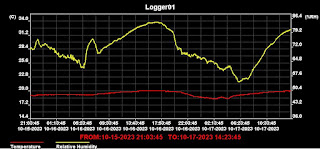While this blog post is not technically directly related to beekeeping we intend to keep it here for "our reference", in our defence however the heating and or cooling out of those experiments and applications may be used to either help cool down or heat up hives in winter and we will ensure to keep you updated on the beekeeping application side for sure too.
This is a post about a few experiments we are running in Gingin Western Australia.
We are generating our own data surrounding the storage of heat in black IBC and other means, in order to potentially utilize the heating and or cooling effect of some of the experiments conducted and or combining some ideas. All data is attached to the blog post, so it can be used for the wider "scientific" audience. It seems its hard to get real life data online these days, hence we are uploading our data freely available here for people to use and study.
The temperature probe we had been using for all experiments is the following found at JayCar: USB Temperature/Humidity Datalogger with LCD | Jaycar Electronics
We basically stuck it into the IBC and made it float by attaching it to a rock and having it float about within the middle of the IBC submerged by about 30-40cm worth of water while the IBC is filled up to the top. The IBC had been painted black or at least of the paint that remained on the IBC after a few month, this side of the picture probably being the worst chipping of the paint from the IBC overall.
Sensor being placed in a little bottle, and tied to the stone pulling it to the ground and making it float about half way in the IBC submerged by water.
Temp Data Graph:
The rise and fall of thermal energy within an IBC on a fairly warm day (16.10.2023):
Water bore - temperature sensore 1.6m below ground within the 1m concrete ring casing.
We had placed the sensor into a pice of pipe and drilled a hole through the top so we could insert a string and hand the sensor as shown into the bore well. The concrete casing is about 1m in diameter and the probe is approximately 1.6m below the surface level just touching the concrete ring while hanging on the string. What is interesting to note is how relatively stable temperature remains regardless of the surface is having a 40 degree Celsius day or not.
Even after a while of having surface temperatures on ongoing basis of over 35C the temperature at 1.6m below ground remains cool enough for us to cool down our drinks by lowering them down into the well too. Its not like a fridge but when drinking a 18-20C water on a 45C day, it feels like heaven!
The temperature probe for the outside is placed outside a 40 ft sea container and held in a pet bottle "stand" as shown:
16.10.2023 day overview:
Happy beekeeping,
----------------------------------------------------------
Our content is for informational purposes only and do not form a professional relationship.
Please refer to the full disclaimer on Quickwings pty ltd’s website found here:
https://quickwings.com.au/policies-and-tcs/
----------------------------------------------------------


























No comments:
Post a Comment